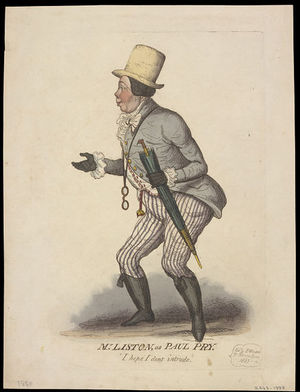Annotation:Paul Pry: Difference between revisions
(Created page with "=='''Back to [[{{BASEPAGENAME}}]]'''== ---- <p><font face="garamond, serif" size="4"> '''PAUL PRY.''' AKA and see “No Place Like Home.” English, Air (6/8 time). G Majo...") |
No edit summary |
||
| Line 2: | Line 2: | ||
---- | ---- | ||
<p><font face="garamond, serif" size="4"> | <p><font face="garamond, serif" size="4"> | ||
'''PAUL PRY.''' AKA and see “[[No Place Like Home]].” English, Air (6/8 time). G Major. Standard tuning (fiddle). AABBCC. '''Paul Pry''' (1825), a farce in three acts, was the most notable play written by 19th-century English playwright John Poole. It premiered in London on 13 September, 1825, at the Haymarket Theatre and ran 114 performances | '''PAUL PRY.''' AKA and see “[[No Place Like Home]].” English, Air (6/8 time). G Major. Standard tuning (fiddle). AABBCC. '''Paul Pry''' (1825), a farce in three acts, was the most notable play written by 19th-century English playwright John Poole. It premiered in London on 13 September, 1825, at the Haymarket Theatre and ran 114 performances, and the play continued to be popular until the early 1870s. So popular was the character that a 'Paul Pry' popularly referred to an excessively inquisitive person. | ||
[[File:pry.jpg|300px|thumb|right|Paul Pry]] | [[File:pry.jpg|300px|thumb|right|Paul Pry]] | ||
<br> | <br> | ||
Revision as of 04:12, 27 August 2015
Back to Paul Pry
PAUL PRY. AKA and see “No Place Like Home.” English, Air (6/8 time). G Major. Standard tuning (fiddle). AABBCC. Paul Pry (1825), a farce in three acts, was the most notable play written by 19th-century English playwright John Poole. It premiered in London on 13 September, 1825, at the Haymarket Theatre and ran 114 performances, and the play continued to be popular until the early 1870s. So popular was the character that a 'Paul Pry' popularly referred to an excessively inquisitive person.

Source for notated version:
Printed sources: Kennedy (Traditional Dance Music of Britain and Ireland: Jigs & Quicksteps, Trips & Humours), 1997; No. 151, p. 37.
Recorded sources:
